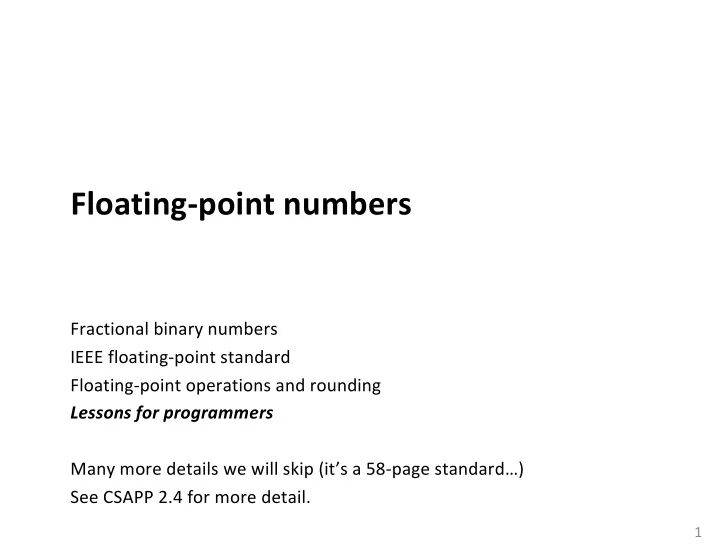

Floating-point numbers Fractional binary numbers IEEE floating-point standard Floating-point operations and rounding Lessons for programmers Many more details we will skip (it’s a 58-page standard…) See CSAPP 2.4 for more detail. 1
Fractional Binary Numbers 2 i 2 i –1 4 2 . 1 b i b i –1 b 2 b 1 b 0 b –1 b –2 b –3 b – j • • • • • • 1/2 1/4 1/8 2 – j i å b k × 2 k k = - j 2
Fractional Binary Numbers Value Representation 5 and 3/4 2 and 7/8 47/64 Observations Shift left = Shift right = Numbers of the form 0.111111… 2 are…? Limitations: Exact representation possible when? 1/3 = 0.333333… 10 = 0.01010101[01]… 2 3
Fixed-Point Representation Implied binary point. b 7 b 6 b 5 b 4 b 3 [.] b 2 b 1 b 0 b 7 b 6 b 5 b 4 b 3 b 2 b 1 b 0 [.] range: difference between largest and smallest representable numbers precision: smallest difference between any two representable numbers fixed point = fixed range, fixed precision 4
IEEE Floating Point Standard 754 IEEE = Institute of Electrical and Electronics Engineers Numerical form: V 10 = (–1) s * M * 2 E Sign bit s determines whether number is negative or positive Significand (mantissa) M usually a fractional value in range [1.0,2.0) Exponent E weights value by a (-/+) power of two Analogous to scientific notation Representation: MSB s = sign bit s exp field encodes E (but is not equal to E) frac field encodes M (but is not equal to M) s exp frac Numerically well-behaved, but hard to make fast in hardware 6
Precisions Single precision (float) : 32 bits s exp frac 1 bit 8 bits 23 bits Double precision (double) : 64 bits s exp frac 1 bit 11 bits 52 bits Finite representation of infinite range… 7
Three kinds of values V = (–1) s * M * 2 E s exp frac 1. Normalized: M = 1.xxxxx… As in scientific notation: 0.011 x 2 5 = 1.1 x 2 3 Representation advantage? 2. Denormalized, near zero: M = 0.xxxxx..., smallest E Evenly space near zero. 3. Special values: 0.0: s = 0 exp = 00...0 frac = 00...0 +inf, -inf: exp = 11...1 frac = 00...0 division by 0.0 frac ¹ 00...0 NaN (“Not a Number”): exp = 11...1 sqrt(-1), ¥ - ¥ , ¥ * 0 , etc. 8
Value distribution -¥ + ¥ -Normalized +Denormalized +Normalized -Denormalized NaN NaN - 0.0 +0.0 9
Normalized values , with float example V = (–1) s * M * 2 E s exp frac n=23 k=8 Value: float f = 12345.0; 12345 10 = 11000000111001 2 = 1.1000000111001 2 x 2 13 (normalized form) Significand: M = 1.1000000111001 2 frac= 10000001110010000000000 2 Exponent: E = exp – Bias à exp = E + Bias E = 13 2 7 – 1 = 2 k-1 – 1 Bias = 127 = Splits exponents roughly -/+ 140 = exp = 10001100 2 Result: 0 10001100 10000001110010000000000 s exp frac 10
2. Denormalized Values: near zero "Near zero": exp = 000 … 0 Exponent: E = 1 + exp – Bias = 1 - Bias not: exp – Bias Significand: leading zero M = 0.xxx … x 2 frac = xxx … x Cases: exp = 000 … 0 , frac = 000 … 0 0.0, -0.0 exp = 000 … 0 , frac ¹ 000 … 0 11
Value distribution example 6-bit IEEE-like format Bias = 2 3-1 – 1 = 3 s exp frac 1 3 2 frac = 00, 01, 10, 11 M = 1.00, 1.01, 1.10, 1.11 s =0, exp =101 E = 5-3 = 2 -15 -10 -5 0 5 10 15 Denormalized Normalized Infinity s =0, exp =110 E = 6-3 = 3 12
Value distribution example (zoom in on 0) 6-bit IEEE-like format Bias = 2 3-1 – 1 = 3 s exp frac 1 3 2 same spacing exp =000 E = 1-3 = -2 s =0, exp =001 s =1, exp =010 Denormalized E = 1-3 = -2 E = 2-3 = -1 = evenly spaced -1 -0.5 0 0.5 1 Denormalized Normalized Infinity 13
Try to represent 3.14, 6-bit example 6-bit IEEE-like format Bias = 2 3-1 – 1 = 3 s exp frac 1 3 2 Value: 3.14; 3.14 = 11.0010 0011 1101 0111 0000 1010 000… = 1.1001 0001 1110 1011 1000 0101 0000… 2 x 2 1 (normalized form) Significand: M = 1.10010001111010111011100001010000… 2 frac= 10 2 Exponent: E = 1 Bias = 3 exp = 4 = 100 2 Result: 1.10 2 × 2 1 = 3 = next highest? 0 100 10 14
Floating Point Arithmetic* V = (–1)s * M * 2E s exp frac double x = ..., y = ...; double z = x + y; 1. Compute exact result. 2. Fix/Round , roughly: Adjust M to fit in [1.0, 2.0)… If M >= 2.0: shift M right, increment E If M < 1.0: shift M left by k, decrement E by k Overflow to infinity if E is too wide for exp Round* M if too wide for frac . Underflow if nearest representable value is 0. … *complicated… 15
Lessons for programmers V = (–1) s * M * 2 E s exp frac float ≠ real number ≠ double Rounding breaks associativity and other properties. double a = ..., b = ...; ... if (a == b) ... if (abs(a - b) < epsilon) ... 16
Recommend
More recommend